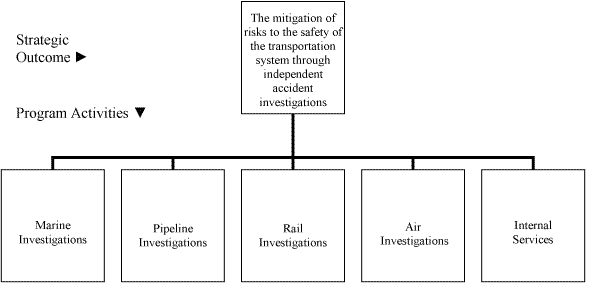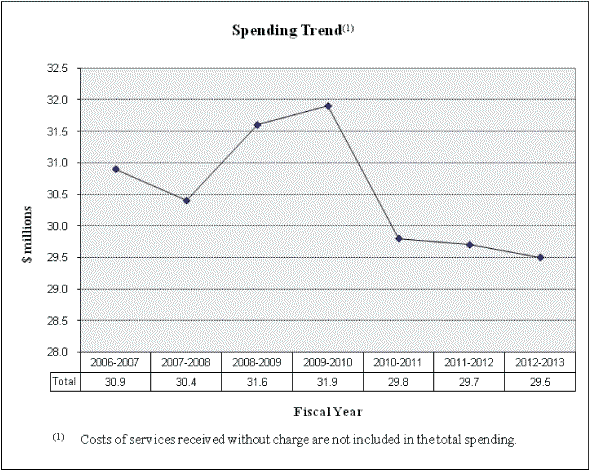Common menu bar links
Breadcrumb Trail
ARCHIVED - Transportation Safety Board of Canada
 This page has been archived.
This page has been archived.
Archived Content
Information identified as archived on the Web is for reference, research or recordkeeping purposes. It has not been altered or updated after the date of archiving. Web pages that are archived on the Web are not subject to the Government of Canada Web Standards. As per the Communications Policy of the Government of Canada, you can request alternate formats on the "Contact Us" page.
Chair's Message
Canadians expect – even demand – a safe and sound transportation system on our waterways, along our pipelines and railways and in our skies. When the system fails and there is an accident, there is a clear public expectation that independent and skilled investigators will shine a light on all of the facts, will determine what risks there are in the system and will call for safety deficiencies to be addressed. The one and only priority for the Transportation Safety Board of Canada (TSB) is to meet these public expectations.
I know we are largely successful. At industry and accident investigation conferences in Canada and around the world, I receive overwhelming positive feedback on the solid reputation and respect enjoyed by the TSB. Thanks to the expertise, professionalism and dedication of our investigators, we will continue to advance transportation safety, one investigation at a time.
This year marks the 20th anniversary of the TSB. We will take this opportunity to communicate more strategically to Canadians our mandate, investigative work and safety accomplishments over time. To this end, we will continue to track the responses to our recommendations and communicate how safety has improved as a result of our work.
The Board will focus on convincing industry and government that they should address the significant risks identified on the TSB's new Safety Watchlist in order to ensure the Canadian transportation system remains one of the safest in the world. We will also leverage technology to maximize the reach of all of our safety messages and seek to increase the uptake on the TSB recommendations.
As a learning organization and a leader in transportation safety, the TSB will continue to invest in the right people, projects and initiatives to strengthen its strategic footprint, increase its overall effectiveness and drive key safety improvements within the transportation sector.
Through continuous efforts to improve business and management practices, the TSB will remain effective and efficient in delivering its mandate—to advance transportation safety.
Section 1: Overview
1.1 Summary Information
Raison d'être and Responsibilities
The Transportation Safety Board of Canada (TSB) is an independent agency created in 1990 by an Act of Parliament (Canadian Transportation Accident Investigation and Safety Board Act). It operates at arm's length from other government departments and agencies to ensure that there are no real or perceived conflicts of interest. The TSB's sole objective is to advance transportation safety. This mandate is fulfilled by conducting independent investigations into selected transportation occurrences. The purpose of these investigations is to identify the causes and contributing factors and the safety deficiencies evidenced by an occurrence. The TSB then makes recommendations to improve safety and reduce or eliminate risks to people, property and the environment.
The jurisdiction of the TSB includes all aviation, marine, rail and pipeline transportation occurrences1 in or over Canada that fall under federal jurisdiction. The TSB may also represent Canadian interests in foreign investigations of transportation accidents involving Canadian registered, licensed or manufactured aircraft, ships or railway rolling stock. In addition, the TSB carries out some of Canada's obligations related to transportation safety at the International Civil Aviation Organization (ICAO) and the International Maritime Organization (IMO).
The TSB is primarily funded by Parliament through an operating expenditures vote and, as a departmental corporation, it has authority to spend revenues received during the year.
For more details on the TSB investigation process or the links between the TSB and other federal organizations visit the TSB website.
Strategic Outcome and Program Activity Architecture
The chart below illustrates the program activities framework that contribute to progress toward the TSB strategic outcome.

1.2 Planning Summary
Resources
The two tables below show information on planned utilization of TSB financial and human resources over the coming three-year period.
| 2010-2011 | 2011-2012 | 2012-2013 |
|---|---|---|
| 29,786 | 29,678 | 29,538 |
| 2010-2011 | 2011-2012 | 2012-2013 |
|---|---|---|
| 235 | 235 | 235 |
* full-time equivalents
The following table shows the contribution of the departmental strategic outcome to the whole-of-government results. It also lists the performance indicators for the TSB strategic outcome. Finally, it provides the results expected of the program activities as well as the planned spending for each one over the next three years. The TSB's baseline funding, as shown in the Main Estimates, is approximately 30 million dollars. It is expected to remain stable over the next three fiscal years.
|
|
| Performance Indicators | |
|---|---|
| Number of transportation occurrences | |
| Number of investigations started, in progress, completed | |
| Specific transportation accident rates(1) | |
| Program Activity(1) | Forecast Spending(2) ($ thousands) 2009-2010 |
Planned Spending(2) ($ thousands) |
Alignment to Government of Canada Outcomes | ||
|---|---|---|---|---|---|
| 2010-2011 | 2011-2012 | 2012-2013 | |||
| Marine Investigations | 5,673 | 5,310 | 5,290 | 5,264 | Safe and secure communities |
| Pipeline Investigations | 400 | 376 | 374 | 372 | Safe and secure communities |
| Rail Investigations | 4,977 | 4,678 | 4,659 | 4,636 | Safe and secure communities |
| Air Investigations | 13,663 | 12,780 | 12,732 | 12,669 | Safe and secure communities |
| Internal Services | 7,221 | 6,642 | 6,623 | 6,597 | Safe and secure communities |
| Total Departmental Spending | 31,934 | 29,786 | 29,678 | 29,538 | Safe and secure communities |
The following table explains the way Parliament voted resources to the TSB and in essence replicates the summary table in the Main Estimates.
| ($ thousands) | |||
| Vote | Vote Wording | 2010-2011 Main Estimates |
2009-2010 Main Estimates |
|---|---|---|---|
| 10 | Canadian Transportation Accident Investigation and Safety Board Program Expenditures |
26,354 | 25,635 |
| (S) | Contributions to employee benefit plans | 3,432 | 3,309 |
| Total | 29,786 | 28,944 | |
The figure below illustrates TSB's spending trend from 2006-2007 to 2012-2013.
Expenditure Profile from 2006-2007 to 2012-2013
For the 2006-2007 to 2009-2010 fiscal years, the total spending includes all Parliamentary appropriations and revenue sources: Main Estimates, Supplementary Estimates, transfers from Treasury Board Votes 10, 15 and 23 and respendable revenues.
It also includes carry forward adjustments of the previous year's lapsed funds.
For the 2010-2011 to 2012-2013 periods, the total spending corresponds only to the Main Estimates planned spending because Treasury Board adjustments and the lapse carry forward are unknown. In real terms, TSB funding has remained virtually the same since 2006-2007.
Risk Analysis
The TSB operates within the context of Canada's very large, complex, dynamic and ever-changing transportation system. The following are the key external and internal factors that could have an impact on the organization's operations and management and the risks they represent.
From an External Point of View
Government in a Deficit Economy
The Government of Canada has projected a deficit in excess of $45 billion for 2010-2011 and continued deficits for the next four years. The Government is now considering implementing restraints in departmental program spending in order to reduce the deficit. The TSB may be affected by such restraints and will have to work with the Treasury Board to ensure it has the resources it needs to continue to deliver on its mandate.
From an Internal Point of View
Development and Maintenance of a Knowledgeable and Professional Workforce
The success of the TSB and its credibility depend largely on the expertise, the professionalism and the competence of its employees. However, the TSB is faced with workforce challenges. Many of the positions are "one deep," that is, there is only one person responsible for a specific task or function. Over the last few years, the TSB has faced a high level of attrition which is expected to continue for the next couple of years. Although the TSB's hiring has increased, the organization has not been able to backfill all departures and ensure good transfer of knowledge.
Product Improvements and Timeliness
The fulfillment of our mandate primarily depends on our ability to deliver, in a timely manner, quality safety products and services that contribute to the achievement of our strategic outcome. The TSB must therefore continue to improve the speed at which it publishes information while maintaining a high level of quality. It must also seek the opinion of stakeholders regarding the quality of its products and services to ensure their efficiency and relevance.
Improvement of Policies, Procedures and Processes
Another challenge pertaining to the organization's management consists in making sure the TSB's information and knowledge are not only stored but also up to date and readily accessible to employees who need it. To this end, the TSB must manage effectively and efficiently its policies, directives and procedures in all activity sectors. This task is especially difficult because of the high employee turnover rate and the TSB's constantly evolving working environment.
Contribution of the Priorities to the Strategic Outcome
After examining the TSB's environment and analyzing the risks and the challenges, senior management has identified four priorities for 2010-2011. The investments dedicated to the projects or initiatives identified for each of them will contribute to the achievement of the TSB strategic outcome over the next three years. These priorities and projects are summarized in the following table.
| Priorities | Type | Description |
|---|---|---|
| Strategic Communication of TSB's mandate, investigative work and safety accomplishments over time | New | In 2010-2011, the TSB will undertake a number of activities to celebrate its 20th anniversary. These activities will involve tracking responses to TSB recommendations over time and communicating how safety has been improved as a result of the organization's work. Significant transportation risks identified on the TSB's new Safety Watchlist will also be communicated to Canadians throughout the year during targeted media and outreach events. At the onset of an occurrence or launch of an investigation, the TSB will also strive to communicate its actions to Canadians early in the process. The TSB will continue to leverage technology, improve its website and explore social media platforms to communicate more effectively, maximize the reach of all its safety messages and increase the uptake of its recommendations. |
| Strategic Human Resources Management | Previously committed | The departmental initiatives that will be implemented to close horizontal gaps identified with regards to human resources management are:
|
| Product Improvements |
Previously committed | We are continuing our efforts aimed at improving our ability to offer, in a timely manner, products most likely to promote changes leading to the reduction of transportation safety risks. This year, we will undertake the following projects:
|
| Policy and Procedure Management Framework | New | We will dedicate resources to:
|

